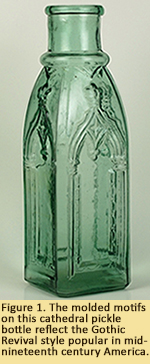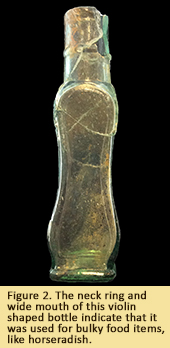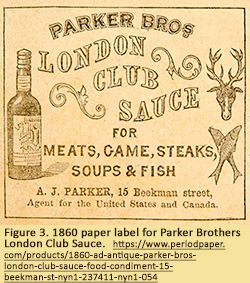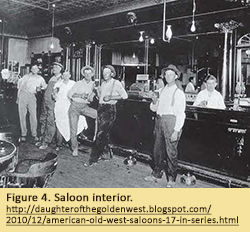Curator's Choice 2019
Culinary Bottle
January 2019
By Patricia Samford, MAC Lab Director
 In mid-nineteenth century America, a wide variety of foodstuffs—pickles, olives, fruits, mustards, ketchup—were available to consumers in glass containers. These culinary bottles were blown and molded in an astonishing array of shapes, sometimes quite specific to the food contained within. Some of them were also quite elaborately decorated by today’s more functional commercial standards (Figure 1).
In mid-nineteenth century America, a wide variety of foodstuffs—pickles, olives, fruits, mustards, ketchup—were available to consumers in glass containers. These culinary bottles were blown and molded in an astonishing array of shapes, sometimes quite specific to the food contained within. Some of them were also quite elaborately decorated by today’s more functional commercial standards (Figure 1).
 The wide-mouthed 8.5” tall bottle shown in Figure 2 was most likely originally used to hold horseradish. The grated root of horseradish was popular among English and German immigrants, who used the condiment to flavor meats and fish, as well as potatoes, cabbage and even bread. Since the process of grating the roots was not only time consuming, but also a sinus irritant, there was a ready market for prepared horseradish (D’Costa 2012). Horseradish became one of the first prepackaged condiments sold in the United States (Wright 2011).
The wide-mouthed 8.5” tall bottle shown in Figure 2 was most likely originally used to hold horseradish. The grated root of horseradish was popular among English and German immigrants, who used the condiment to flavor meats and fish, as well as potatoes, cabbage and even bread. Since the process of grating the roots was not only time consuming, but also a sinus irritant, there was a ready market for prepared horseradish (D’Costa 2012). Horseradish became one of the first prepackaged condiments sold in the United States (Wright 2011).
The fragmented bottle had been discarded in a mid-nineteenth-century privy in the Jones Falls area of Baltimore (18BC66). Filled mainly with glass and stoneware liquor bottles, this privy appeared to have been associated with a saloon, possibly owned by Robert B. Elliott. During this period, the neighborhood contained a number of eating and drinking establishments that catered to laborers associated with the maritime industries.
Since the original foil or paper label did not survive the acidic environment of the privy, it is impossible to say with certainty that the bottle held horseradish. This shape has also been used for pickles. Another culinary bottle—Parker Brothers London Club Sauce—was also recovered in the privy. This product, which can probably be best compared to A-1 steak sauce, was marketed for use with meats, game, steaks, soups, and fish. It is easy to imagine Elliott’s saloon offering horseradish and club sauce alongside hearty, simple steak and chop meals for its working-class customers.


References